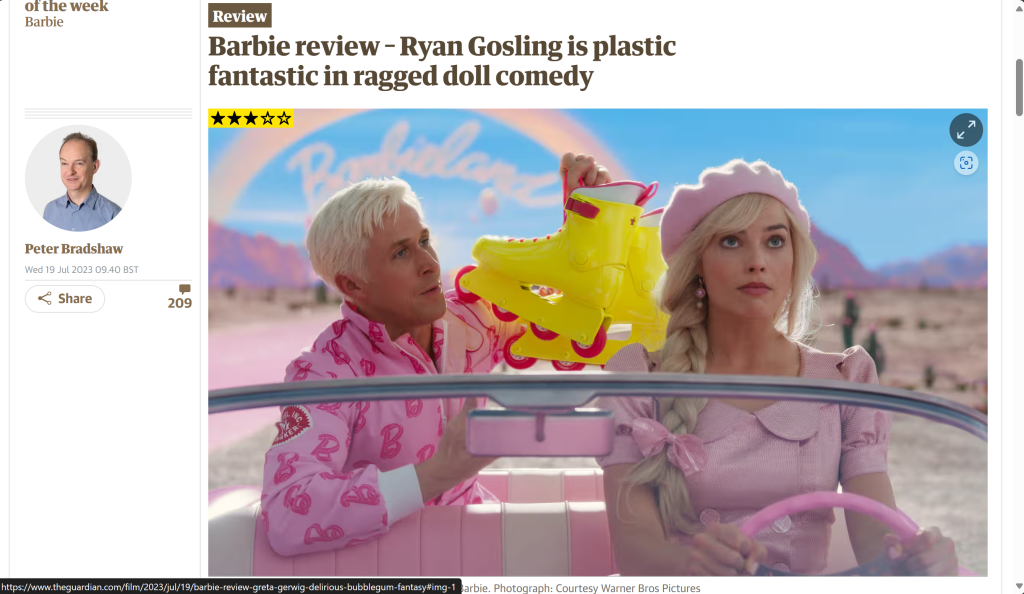Hello everyone, today I’d like to talk to you about the male gaze in movies. “Gaze” is an important concept in Western literary theory and cultural criticism. As a sociocultural concept, it implies a power structure relationship between the observer and the observed, because compared with one-way viewing, ” Gaze ” can make the object of the gaze feel that he is being watched. The concept of “Male Gaze” was first proposed by feminist film theorist Laura Mulvey in her 1975 article Visual Pleasure and Narrative Film (Loreck, 2016). In the course of the historical development of the society, the male gaze has been integrated into the expression of the film lens in a subtle way.
In the silent film era, film cameras began to distinguish female characters by good girls and witches, and to explore whether they might get a powerful viewing to reward the men who stared at them. Many of the “good girl” characters of the silent film period were often blind, and obstructed vision was often an important sign of their sexual purity (such as City Lights). On the contrary, only female figures such as the “witches” have the ability to watch and can be seen. Williams (2015) points out that the “witches”has a low moral and social status and instead gets the power to stare. This situation of judging and dividing the value of women through the male gaze is the abbreviation of the film lens of that era.
However, with the development of The Times, in recent years, the eyes have a close relationship with rights and subjects. In public discussions, due to the need of women’s increasingly rising ontology, the patrilineal discourse and related power strategies represented by the “male gaze” have also been continuously perspective and exposed from many daily phenomena.
In the blockbuster film Barbie in 2023, we see Barbie as a product of the male aesthetic and object gaze, as a commodity that succeeds in the logic of capital by selling female identity and role expectations, and in a world dominated by sexual imbalances, the pleasure of viewing is split into active/male and passive/female. The decisive male gaze projects its fantasy onto the female figure (Durham and Kellner, 2012). And because of this, Barbie’s initial beauty in the film is nothing more than “cognitive dissonance under patriarchal oppression,” an accomplice to the discipline of women embedded in consumerism, patriarchal gaze, and racism. But through the description of Barbie’s awakening process, we can see the rise of feminism and the reflection of women’s reality.
Contemporary news media’s in-depth comments on the movie Barbie
Although there have been more and more film shows showing the reaction to the male gaze and the emphasis on feminism, it has to be admitted that the ingrained androgynism in the film lens is still difficult to eradicate. In male-dominated films, women are often presented in images that are meaningful to men. Although the importance of women is emphasized, they can only play the function of symbols. The man can act out his fantasies and obdurations through verbal commands, imposing them on the silent image of the woman, who remains tied to her status as the bearer of meaning rather than the maker of meaning (Durham and Kellner, 2012).
Therefore, in the future development, the male gaze in the film lens is still a problem worthy of continuous attention, and only by constantly revealing, reflecting and reflecting on the concerns of men in the film can we truly achieve the progress of gender equality. By constantly challenging and deconstructing the traditional male gaze, film can be a powerful tool for social change, allowing more gender perspectives to be equally expressed and respected.
Reference
Bradshaw, P. (2023). Barbie review – Ryan Gosling is plastic fantastic in ragged doll comedy. The Guardian, July 19. Available from Barbie review – Ryan Gosling is plastic fantastic in ragged doll comedy | Barbie | The Guardian [Accessed 27 Noverber 2024].
Bramesco, C. (2023). Barbie: the patriarchy, the existentialism, the capitalism – discuss with spoilers.The Guardian, July 24. Available from Barbie: the patriarchy, the existentialism, the capitalism – discuss with spoilers | Barbie | The Guardian [Accessed 27 Noverber 2024].
Durham, M. G. and Kellner, D. M. (Eds.). (2012). Media and cultural studies: Keyworks. John Wiley & Sons.
Loreck, J. (2016). Explainer: what does the ‘male gaze’ mean, and what about a female gaze? THE CONVERSATION, January 5. Available from Explainer: what does the ‘male gaze’ mean, and what about a female gaze? (theconversation.com) [Accessed 27 Noverber 2024].
Williams, L. (2015). 3 When the Woman Looks. In The Dread of Difference, 2nd ed. Gender and the Horror Film. University of Texas Press, 17-36.
https://people.com/movies/barbie-movie-everything-to-know/
https://www.charliechaplin.com/en/films/5-City-Lights/articles/4-Filming-City-Lights
http://xhslink.com/a/Sey4Jh6fhfA0






This article delves into the concept of male gaze from a cinematic perspective, covering the evolution from silent films to contemporary works such as Barbie. It highlights how films often objectify women, describing women from a patriarchal perspective. What is particularly interesting is the perspective on feminism’s counterattack against traditional narratives and how to use movies to promote gender equality. This blog makes me focus more on the gender discrimination behind film, which is really inspiring!